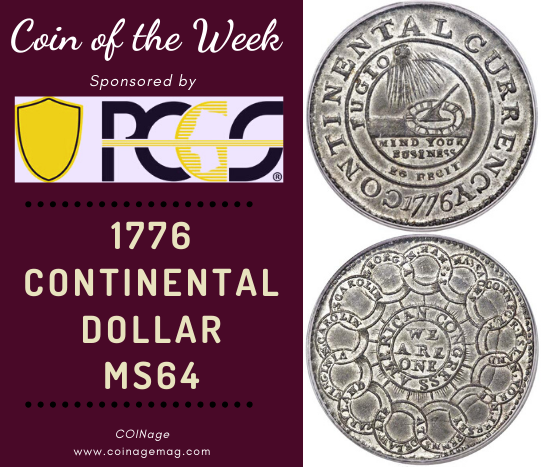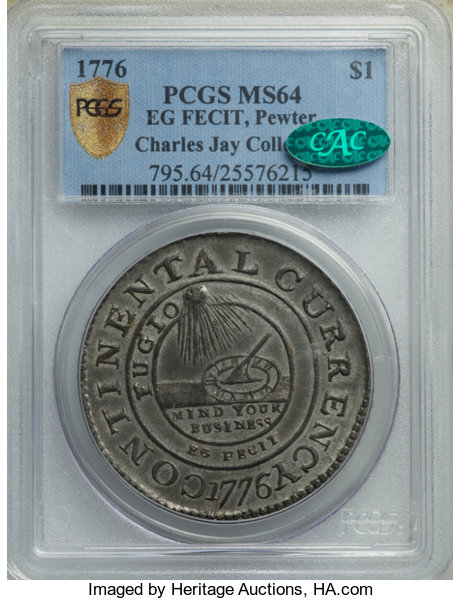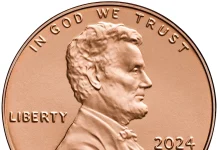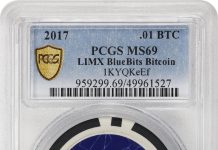
By Antoinette Rahn
For anyone who questions how collecting and studying coins is a hobby of multi-topic appeal, the 1776 Continental Dollar is a wonderful example of not only how, but why.
If the concept of questioning the how or why of coin collecting is a bit baffling to you, then 1.) You most certainly are a numismatist and 2.) Stay with me, and I promise this brief examination of the 1776 Continental Dollar is entertaining.
Inviting Study and Exploration
This single coin undoubtedly invites study and appreciation of history, art, investigation, and mystery, and of course, coin production and collection. Among the most obvious of the intriguing elements of this coin is its representation of colonial America. As the U.S. was taking

(All photos courtesy Heritage Auction)
its earliest steps in formation and independence, this monetary specimen was part of progress. Whenever I read or hear about early-era coins coming to or selling at auction, I can’t help but think about the sheer number of people and the possibility of some notable historical figures who may have handled or viewed these coins.
The 1776 Continental Dollar, MS64 PCGS. CAC that is the featured Coin of the Week, sponsored by PCGS, has a fascinating history. Part of that history is the claim of being part of some elite numismatic collections, dating back to the earliest days of the hobby, according to the Heritage Auctions lot description.
It’s reported there are an estimated 300 or so examples of this coin still in existence today. Furthermore, as the lot description stated, only a few dozen of those are in high Mint State grades, which include this Coin of the Week example. Another interesting aspect of the 1776 Continental Dollar history is that while the coin was mostly issued in pewter, research reveals scarce examples of brass and silver issues
Intrigued by Origin
As with early coins and currency, there is an element of mystery within this coin’s history. Some authorities within numismatics trace the design of the dollar to inspiration from the design of fractional U.S. bills, issued between 1775 and 1779. The motif seems to speak to an adaption of that which is present on the early currency, it’s been said. On the other hand, some numismatic experts describe the coin not as a U.S. dollar, but as a 1783 medal produced in Europe, according to Heritage Auctions auction description.
How’s that for a bit of a mystery? While the truth of its origins may remain the topic of debate, based on recent performance at auction, the popularity of this historical piece is without question. During the 2020 Central States U.S. Coins Signature Auction presented virtually by Heritage Auctions on April 23-24 and 26, this Coin, described as a near-Gem grade, sold for $138,000.
If you are looking to continue your study of this coin and its origins, you can do so by putting your American Numismatic Association (ANA) membership to work for you. An ANA membership comes with access to the digital archive of The Numismatist, the flagship publication of the ANA. Two articles about this topic, as noted by Heritage Auctions, include “The Continental Dollar of 1776 Meets Its Maker” by Eric P. Newman, published in the August 1959 issue. As well as articles in the January 2018 and July 2018 issues of The Numismatist, written by Erik Goldstein and David McCarthy, and Goldstein, respectively.













